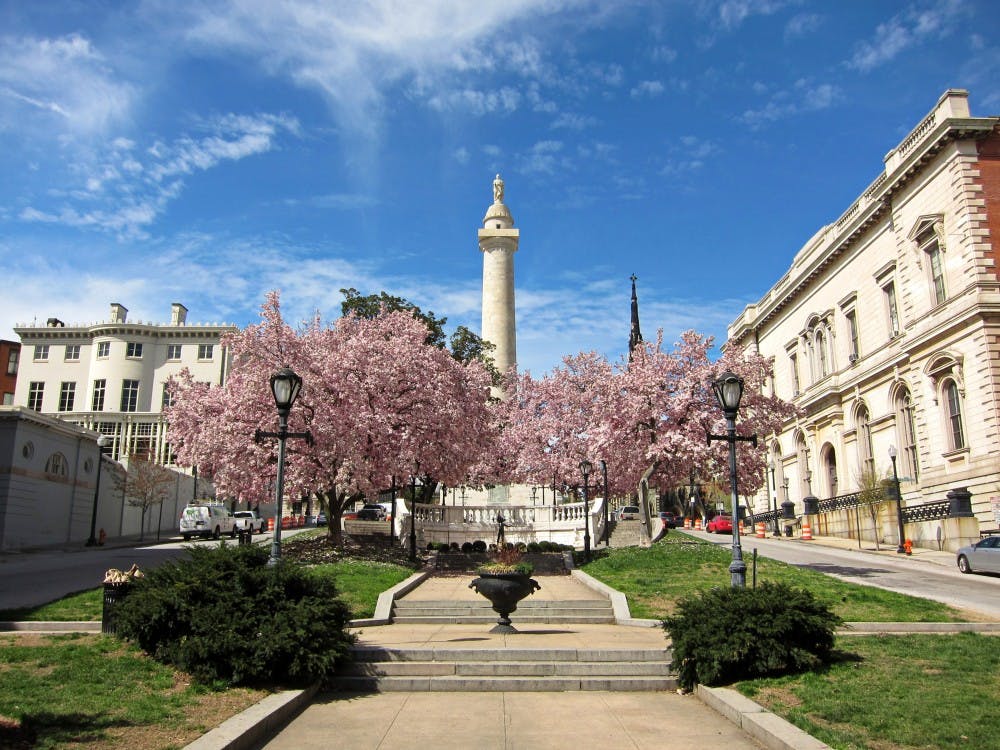A famous line in the Hamilton soundtrack comes in a somber song, “It’s Quiet Uptown,” after the death of Alexander Hamilton’s son: “They say he walks the length of the city” to mourn and reflect.
While I’ve never had or lost a son, the image of someone walking the length of a city is powerful to me. It made me wonder what I would discover if I did just that, here in Baltimore.
It was a Saturday early in the month, a time of year when a bitter wind chill combines itself with peculiarly direct rays of sun, leaving you simultaneously cold and warm. I donned a light jacket, grabbed an apple at CharMar, and began my five-mile walk south down North Charles Street to the Inner Harbor.
The previous semester, I’d spent an hour studying a map of Baltimore, so I knew the neighborhoods I’d be passing through. What I was not prepared to find was how the architecture, demographics and establishments of the City changed as I arrived in each new neighborhood.
Take the change in the last leg of my trek, walking from lower Mount Vernon to the Inner Harbor. I immediately knew I’d hit the Harbor when I realized I had to crane my neck in order to see the tops of the buildings.
If that was not enough proof of the neighborhood switch, I could observe the sheer modernity of the skyscrapers in the Inner Harbor compared to the rich cultural significance displayed in the stone architecture of the Mount Vernon cathedrals, statues and surrounding apartment buildings.
Both the best and worst part of my walk was when I realized that I’d never paid attention to many neighborhoods.
I largely ignored them — they could’ve been compared to “flyover states,” one passed over as one flies from the east to west coast.
I felt bad that when I’d ridden the Circulator downtown in the past, I’d stared at my phone instead of looking out the window, only caring about Hopkins, my starting point, and the Harbor, my destination.
One such area is between Charles Village and Old Goucher, right above the hip Station North district. When I later returned to the neighborhood, I discovered Yum’s Asian Bistro on 25th Street, a true hidden gem.
One block further, there’s a pleasant Safeway where I often find great deals on really fresh food. I’m grateful I made the trip by foot because it forced me to open my eyes and explore lesser traveled parts of Baltimore.
Station North, a fun area that surrounds the University of Baltimore, was a place I hadn’t explored previously in depth. I wrote down the names of restaurants I wanted to return to, most notably XS, where I later took some friends for a girls’ night out. A four-story restaurant, XS features great American treats like grilled cheese, paninis and all-day breakfast, along with daily deals on Asian and Mexican dishes, including great sushi.
If you find yourself in Station North at night, stop by, and also be sure to wander in for a free show by Baltimore Improv Group.
Walking around at breakfast time? Mount Vernon, the neighborhood below Station North, is the place to go for a more hipster morning experience. I stopped at Baby’s on Fire during my walk down Charles Street — it’s an iconic cafe that offers delicious breakfast sandwiches, pastries and drinks, surrounded by vintage posters and an array of old records available for purchase.
When I have no idea what I want for dinner, Mount Vernon is my go-to place. Upper Mount Vernon (around Peabody’s neighborhood) and Lower Mount Vernon (the area south of the Washington Monument) showcase Baltimore’s best variety of ethnic restaurant options.
Try Minato for great sushi happy hour deals; The Helmand for Afghani food when you’re feeling adventurous; or Mount Vernon Marketplace, a more artsy version of Remington’s R. House.
When I finally reached the Inner Harbor during my walk, I felt like I’d burned enough calories for the month, but I was also proud to have learned at least one stretch of the City.
Passing by the aforementioned restaurants motivated me to return and try them; passing through the area right below campus encouraged me to look further into Baltimore’s appalling income disparity; and voluntarily participating in such a walk made me proud to be a part of Baltimore culture.
The experience pushed me to continue exploring the City whenever possible, and I now see it as both a place with much to offer and a place to which I feel obliged to give back.

















